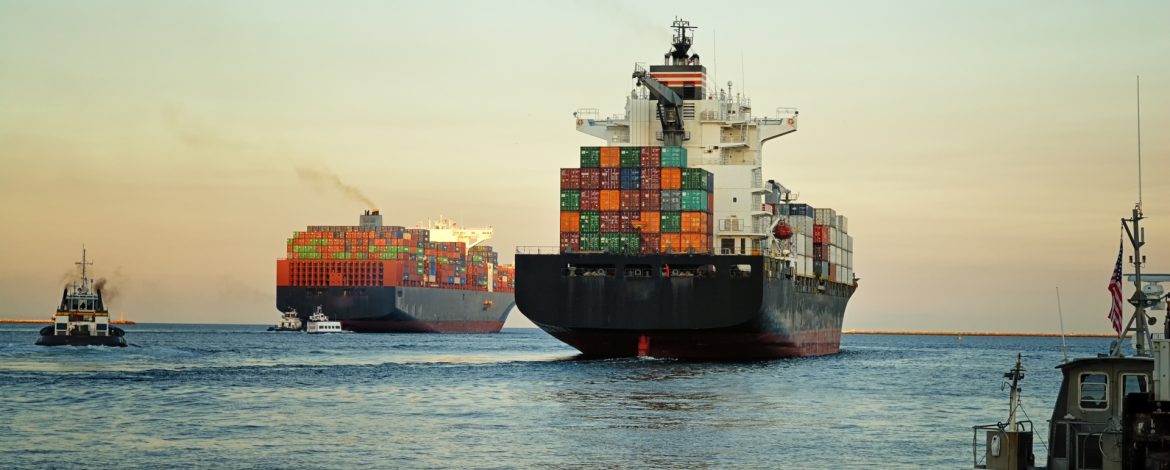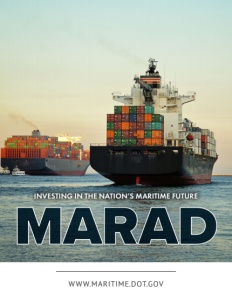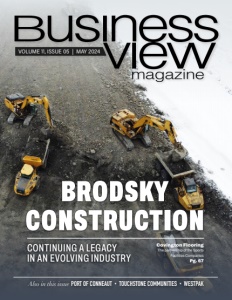MARAD
Investing in the Nation’s Maritime Future
Navigating the right course without turbulent waters
The Maritime Administration (also known as “MARAD”) was established in 1950 and plays a central role in the commerce of the United States. Government involvement in the nation’s maritime industry has a lengthy history dating back more than a century to the Shipping Act of 1916. This legislation established a framework for the regulation of U.S. commercial shipping and acted to promote a U.S. merchant
marine. Today, MARAD is a vital part of the U.S. Department of Transportation (“USDOT”). The overall mission statement of the agency is “To foster, promote and develop the maritime industry of the United States to meet the nation’s economic and security needs”.
MARAD’s focus continues to be the support and promotion of the nation’s waterborne transportation system. This encompasses a variety of functions including enhancing the nation’s maritime infrastructure via federal grants for port and intermodal improvements, supporting small shipyard projects that make capital and related improvements, promoting the use of the nation’s marine highways and navigable waterways, providing loan guarantees to U.S. built, owned, operated and flagged merchant vessels, operating the U.S. Merchant Marine Academy, and operating and maintaining the “Ready Reserve” fleet, a set of multi-purpose vessels poised to support national security requirements.
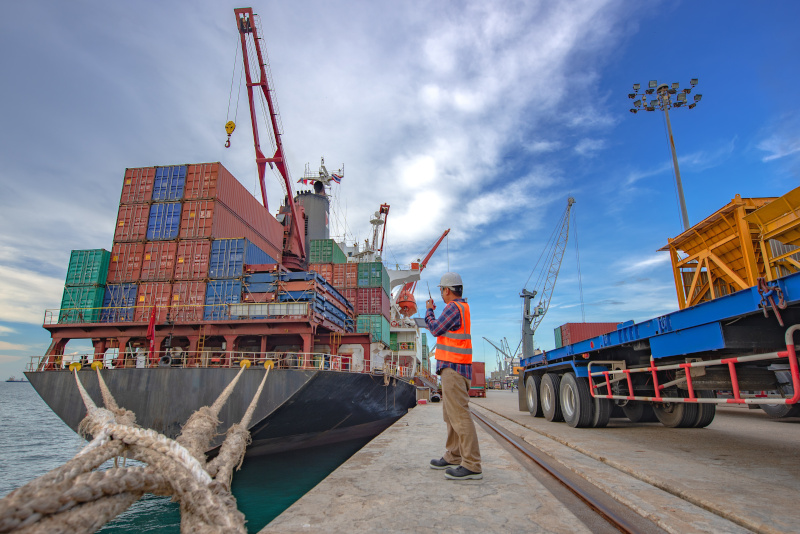
The Bipartisan Infrastructure Law (“BIL”), signed into law by President Biden in November 2021, invests $16.7 billion to improve infrastructure at coastal ports, inland ports and waterways, and land ports of entry along the nation’s borders1. The increased funding allows USDOT, MARAD, and other federal agencies to consider a wider variety of improvements over a greater range of facilities and geographical areas. The result is increased interest in maritime improvements from a more diverse set of stakeholders, such as small ports, ports in tribal areas, as well as ports in rural or economically disadvantaged areas.
The nation’s maritime industry is undergoing a renaissance due to a combination of BIL funding and large-scale technological improvements. The “lessons learned” from the port congestion and supply chain crisis during the COVID-19 pandemic is realigning how ports, terminals, and intermodal carriers handle containerized and “break-bulk” cargoes. Due to USDOT, MARAD, and other federal agencies’ funding, ports are improving cargo storage and conveyance to and from docks and piers, addressing long-deferred maintenance of maritime infrastructure, increasing port capacity, and addressing cargo handling equipment needs. This historical investment in maritime infrastructure, as well as operational improvements to the supply chain learned through the COVID-19 crisis, will assist in the continuous transformation of the nation’s maritime industry.
One of the biggest challenges over the last few years has been overcoming the public perception of overwhelmed ports – as either the cause or result of the COVID-19 supply chain crisis. MARAD continues to work with all stakeholders, such as ocean and inland waterways carriers, terminal operators, trucking companies, freight forwarders, and warehouse providers, enlisting their ideas on fostering the maritime industry. This outreach is reinforced through the promotion of several grant programs administered by MARAD. These include the Port Infrastructure and Development Program (“PIDP”), the Small Shipyard Grant Program, and the United States Marine Highway Program. Eligible applicants are invited to apply and put forward their proposals for enhancements and improvements to terminals and facilities.
1 https://www.whitehouse.gov/wp-content/uploads/2022/05/BUILDING-A-BETTER-AMERICA-V2.pdf#page=99
Funds for the PIDP are awarded on a competitive basis to projects that improve the safety, efficiency, or reliability of the movement of goods into, out of, around, or within a port. PIDP grants support efforts to improve port and related freight infrastructure to meet the nation’s freight transportation needs and ensure our port infrastructure can meet anticipated growth in freight volumes. The PIDP provides funding to ports in both urban and rural areas for planning and capital projects. It also includes a statutory set-aside for small ports to continue to improve and expand their capacity to move freight reliably and efficiently and support local and regional economies. The Bipartisan Infrastructure Law provided $2.25 billion for the PIDP program over five years (2022-2026), $450,000,000 of which is currently available in fiscal year 2024. Additional funding may be appropriated in fiscal year 2024 for PIDP under the annual appropriations act. MARAD published a preliminary Notice of Funding Opportunity (NOFO) on December 27, 2023, and will update the NOFO on or before February 16th, 2024.
MARAD grant programs include provisions that applicants address safety, efficiency, and reliability of their projects, including environmental considerations such as emission mitigation measures, port electrification, and hydrogen refueling infrastructure. In addition, MARAD, through its Marine Highway Program, continues to engage the maritime industry on how to leverage the availability and increase the use of the nation’s navigable waterways to relieve landside congestion, reduce air emissions, and generate other public benefits. This engagement includes investigating maritime transportation opportunities to Canada and Mexico.
The latest developments in the port industry include the realization that low and zero emission maritime infrastructure and cargo handling equipment can be economically viable and can provide a substantial monetary savings to operate over time, despite potentially higher upfront costs. These economic benefits are complemented with clear positive environmental impacts. This “sea change” is supported not only by MARAD grants but also through other USDOT grants, such as the Federal Highway Administration (“FHWA”) through their multiyear $160 million Reduction of Truck Emissions at Port Facilities (“RTEPF”) program.
In addition to federal investment in maritime infrastructure, ports are economic drivers and contribute to infrastructure developments. Ports are economic development drivers for local and state governments. Ports can have the authority to own land, set fees, and levy taxes, for example. They are usually self-sustaining and often operate airports or shipping terminals and support a range of community and economic development goals. Local and state governments frequently establish port authorities to promote or support economic development (Bowen-Ellzey & Stewart, 2019).
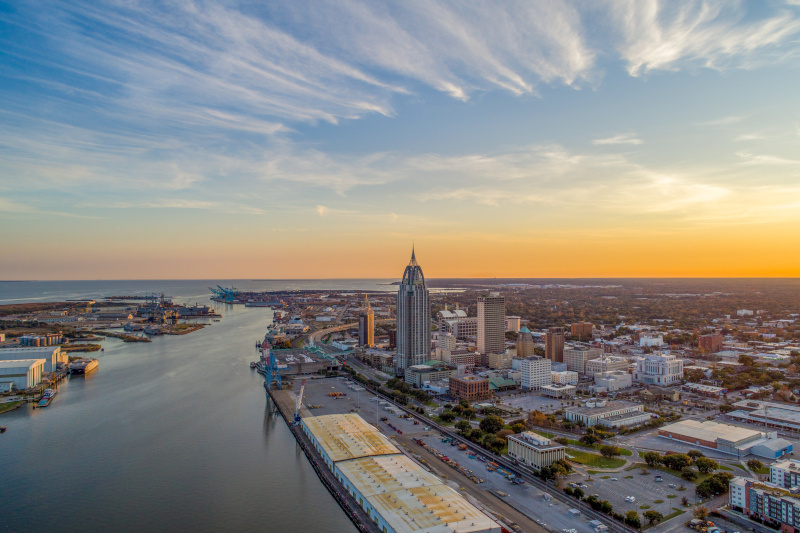
In addition, ports can have sizable landholdings under their jurisdiction. The most noticeable way these entities contribute to their region is by acting as “incubators” of economic development through the lease of property to companies that add value to cargoes that are moving through their respective ports either domestically or in the form of imports and exports. This variety of economic activity takes many forms and ranges from the simple stuffing and devanning of containers to the intricate assembly of high value equipment in Foreign Trade Zones. The common bond in these activities is the port itself and the key role it plays as a point of entry (or exit) for commodities that will then undergo further handling and/or enhancement.
Ideally, a port will employ the “best and highest use” criteria in its choice of economic initiatives. Examples include the leasing of properties for shipbuilding activities, allowing the use of sites within a port for final assembly of imported vehicles, and providing warehouse space for the construction of
prefabricated buildings with lumber and other building materials landed at a port via domestic barging. Depending on the size of the port, hundreds to thousands of long-term family wage jobs are created.
Along with investment in the physical infrastructure of the U.S. maritime transportation system, MARAD is working to ensure growth of our U.S.-flag fleet of vessels that support economic and national security. Having a robust fleet of domestic and internationally-trading vessels ensures that our nation’s economy
continues to thrive and that we are ready as a nation to respond in times of national need, like humanitarian and disaster relief or wartime operations. Programs like the Maritime Security Program, Tanker Security Program, and Cable Security Fleet Program aim to sustain a robust fleet crewed by U.S. mariners who also possess the necessary credentials to crew our nation’s Ready Reserve Force (RRF). The RRF, when activated, carries vital military equipment, and ensures that our nation’s military is ready to execute its mission anywhere across the globe at any time.
This investment in maritime infrastructure and the economic growth in the industry is not possible without a well-trained maritime workforce. Workforce education and training is a vital component in ensuring the economic growth of the industry, especially in today’s work environment that is seeing historic labor shortages across the maritime industry. There are several efforts currently underway to address the current shortage in the maritime workforce, both ashore and afloat. Infrastructure improvements at the Federal U.S. Merchant Marine Academy aim to modernize and improve the education and training of our future mariner workforce, and programs like the Student Incentive Program continue to attract mariners to the industry. However, further investment is paramount. Investing in more activities like industry marketing and a broader incentive program could cast a wider net and attract a new generation of workforce. Potential also lies in MARAD’s Centers of Excellence for Domestic Maritime Workforce Training and Education (CoE) Program, which recognizes maritime training and education institutions across the country. In addition to these programs, a sizable number of young people continue to realize the value of a career in this field through a nation-wide network of maritime high schools in waterfront communities. Over the past few years, new schools have opened and others are expanding their scope. MARAD expects that this can lead to consistent enrollment at the U.S. Merchant Marine Academy as well the six State Maritime Academies and Colleges. This enthusiasm and positive momentum are all indicators of a strong future for the maritime workforce.
Through historical investment in maritime infrastructure, building the U.S.-flag fleet, and the promotion of the maritime industry as a whole, USDOT, MARAD, and other federal agencies assist in developing and maintaining port infrastructure thus assuring that these enterprises can be sustained long term and this base of activity and employment will flourish.
AT A GLANCE
MARAD
What: A part of the U.S. Department of Transportation (“USDOT”) with the mission statement “To foster, promote and develop the maritime industry of the United States to meet the nation’s economic and security needs”
Where: Washington, D.C.
Website: https://www.maritime.dot.gov/
